The guy had to suffer for this composition, if only to find the 10 (!) black knights in his favourite shop.
a resourceful position for the 3rd study
3 - White to play and make the best of it
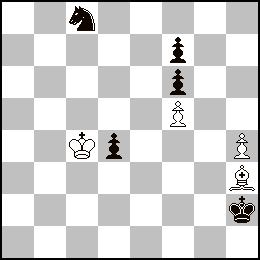
W.: Kc4, Bh3, pf5 and h4
B.: Kh2, Nc8, pd4, f6 and f7
The fourth is a full rescue
4 - white plays and does the best (i.e. the least worst in this case)
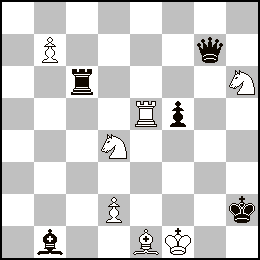
W.: Kf1, Re5, Be1, Nd4 and h6, pb7 and d2
B.: Kh2, Qg7, Rc6, Bb1, pf5
Black has some pretty severe threats that will have to be dealt with virilely.
A little exercise to wait for the 29th of May
5 - White has put Rb4 --> d4 as sealed move, the move goes to Black who can win the game. Instead of the winning move, they played Fxe4 which relieves White and allows him to breathe a sigh of relief and leave with a draw and the title of Paris Champion in his pocket.
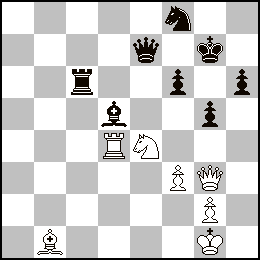
W.: Kg1, Qg3, Rd4, Bb1, Ne4, pf3 and g2
B.: Kg7, Qe7, Rc6, Bd5, Nf8, pf6, g5 and h6
Let loose on the threats
Today's game is an old-fashioned fight.
6 - game of the day
1. e4 e6 2. d4 d5 3. Nd2 c5 4. dc Bxc5 5. Nb3 Bb6 6. ed Nf6 7. Bb5+ (sweeper's trap 7. dxe Bxf2+) Bd7 8. Bxd7 Qxd7 9. c4 ed 10. c5 Bc7 11. Nf3 Nc6 12. 0-0 0-0 13. Nbd4 NxN 14. Qxd4 Rfe8 15. Be3 ?! (15. Bg5 Ne4 16. Rad1 Nxg5 17. Nxg5 Rad8 and everything is in order for White in relation to the game) Re4 16. Qd3 Rae8 17. Rfd1 h6 18. a3 ? (18. h3) Qg4 19. b4 g5 20. Qc3 Qf5 21. Qd3 Qg6 22. Qb5 Qh5 23. Qxb7 Bxh2+ 24. Nxh2 Rh4 25. f3 (25. Qc7 Ng4 26. f3 Nxh2 27. Rxd5 Nxf3 28. Kf2 Rc4 !) Rxh2 26. Qc7 Rh1+ Kf2 Qh4+ 28. Qg3 Qxg3+ 29. Kxg3 RxR 30. RxR Rxe3 and the greffier's pen was tired, but the white position
is rotten even when your name is Steinitz.
During the meal Master Guy treated us to some of his world premieres, which was impressive.
The Master, between two mouthfuls, presented us some of the compositions he had selected.
For the warm-up, a direct problem, but still with some deviations from the rules.
7 - #2 Transmuted Kings + Rose en b7
Transmuted Kings : the King catches the march of the piece that gives him check
Rose : Extended knight with a circular movement. On an empty board Roe1 can play for example g2, h4, g6, e7, c6, b4, c2 and e1
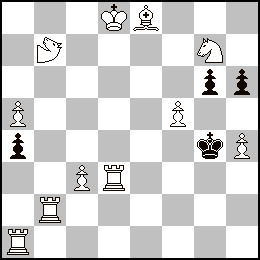
W.: Kd8 Ra1, b2 and d3, Be8, Ng7, pa5, f5 and h4, Rob7
B.: Kg4, pa4, g6 and h6
Caillaud - Lörinc pure juice
A small Heinonen to continue with a light position (especially on the white side)
8 - hs#21
helped selfmate : white to play. white and black cooperate until the penultimate move, after which white plays and black finds himself in a position where he is forced to checkmate in one move

W.: Kb8 (!)
B.: Ke7, Bb6 and e6, pb7, c4 and c6
Great art
The rest is a bit harder (like Rammstein)
9 - s#6 Köko
selfmate : white plays and forces black to checkmate
Köko (Kölnischer Kontakt) : at the arrival of the move the piece (or pawn) must be in contact with another piece (or pawn)

W.: Kh4 Qf3, Ra3 and e8
B.: Kf1
A little diversions to the Madrasi now
10 - serial h#7 Madrasi 2 solutions
helpmate : Black plays and helps Whites to checkmate them
serial helpmate : black plays n moves in a row to help white checkmate them
Madrasi : Opposing pieces of the same kind that control each other are paralysed.
2 solutions : there are 2 distinct ways to satisfy the statement
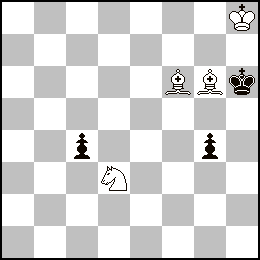
W.: Kh8, Bf6 and g6, Nd3
B.: Kh6, pc4 and g4
Very cute
To end up with your head turned upside down, we go to the Isardam of the Scottish Caillaud
11 - s#3 Isardam
isardam : it is strictly illegal to put in mutual control 2 opposite pieces of the same nature
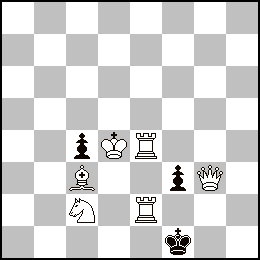
W.: Kd4, Qg3, Re2 and e4, Bc3, Nc2
B.: Kf1, pc4 and f3
That's it for today.
See you on 29 May.
Sincerely yours
Add a comment